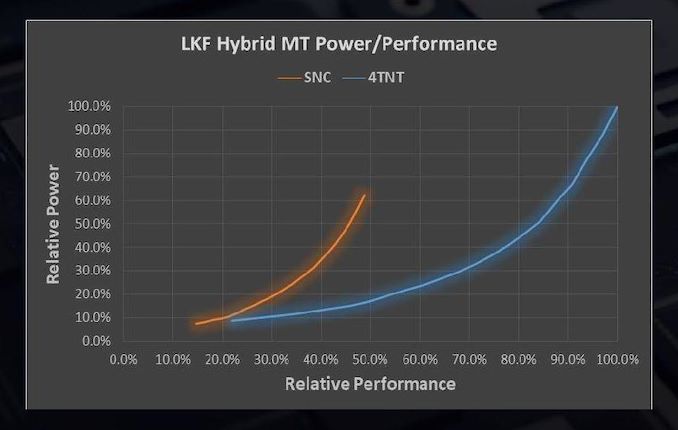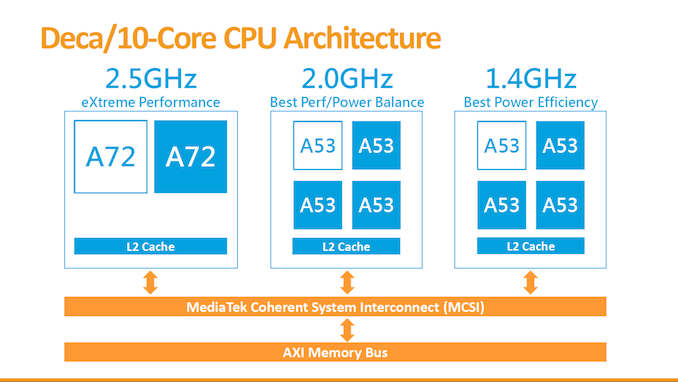The Intel Lakefield Deep Dive: Everything To Know About the First x86 Hybrid CPU
by Dr. Ian Cutress on July 2, 2020 9:00 AM ESTHow To Treat a 1+4 Hybrid CPU
At the top of the article, I explained that the reason for using two different types of processor core, one big on performance and the other big on efficiency, was that users could get the best of both worlds depending on if a workload could be run efficiently in the background, or needed the high performance for a user experience interaction. You may have caught onto the fact that I also stated that because Intel is using a 1+4 design, it actually makes more sense for multi-threaded workloads to run on the four Atom cores.
Using a similar power/performance graphs, the effect of having a 1+4 design is quite substantial. On the left is the single core power/performance graphs, but on the right is when we compare 1 Sunny Cove to all 4 Tremont cores working together.
Where the previous graph considered a 1+1 design, which is more relevant in those user experience scenarios listed above, on the right is the 1+4 design for when the user demands a heavier workload that might not be latency critical. Because there are four Atom cores, the blue line multiplies by four in both directions.
Now obviously the real world scenario is somewhere between the two, as it is possible to use only one, two, or three of the smaller cores at any given time. The CPU and the OS is expected to know this, so it can govern when workloads that can be split across multiple cores end up on either the big core or the small core.
In this graph from Intel, we have three distinct modes on which threads can operate.
- ‘Sunny Cove/SNC’ is for responsiveness and user experience threads,
- ‘Tremont/TNT Foreground’, for user related tasks that require multiple threads that the user is waiting on.
- ‘Tremont/TNT Background’, for non-user related tasks run in efficiency mode
Even though the example here is web browsing, it might be best to consider something a bit beefier, like video encoding.
If we run video encoding, because it is a user related task that requires multiple threads, it will run on the four Tremont cores (TNT FG). Anything that Windows wants to do alongside that gets scheduled as TNT BG. If we then open up the start menu, because that is a responsiveness task, that gets scheduled on the SNC core.
Is 1+4 the Correct Configuration?
Intel here has implemented a 1+4 core design, however in the smartphone space, things are seen a little differently. The most popular configuration, by far, is a 4+4 design, simply because a lot of smartphone code is written to take advantage of multiple foreground or multiple background threads. There are a number of cost-down designs that reduce die area and power by going for a 2+4 implementation. Everyone seems adamant that 4 is a good number for the smaller cores, partly because they are small and cheap to add, but because Arm’s quad-core implementation is a base unit for its IP.
The smartphone space in recent quarters has also evolved from a two tier system of cores. In some of the more leading edge designs, we now have three types of core: a big, a middle, and a small. Because of the tendency to stay with eight core designs, we now get 1+3+4 or 2+2+4 designs, powered by complex schedulers that manage where to put the threads for the best user experience, the best battery life, or somewhere in the middle. Mediatek has been famously dabbling in 10 core designs, going for a 2+4+4 approach.
One thing missing from all of these implementations is an SoC with one big core and four small cores. Smartphone vendors don’t seem to be interested in 1+4 silicon, and yet Intel has decided on it for Lakefield. This is borne out of decisions made on both sides.
From the smartphone perspective, when hybrid designs came about, the big cores just weren’t powerful enough on their own. In order to offer something more than simply basic, at least two cores were needed, but because of how Arm architected the big and little designs, it almost became standard to look into 4+4 implementations of big and small cores. It was only until this configuration was popularized over a couple of years, and Arm big cores got more powerful, that chip designs started looking at 2+4, or 1+3+4 designs.
On Intel’s side of the fence, the biggest problem it has is the size of the Sunny Cove core. By comparison, it’s really, really big. Because the graphics core is the same as Ice Lake and reuses its design, there simply isn’t enough room within the 82 mm2 compute die to add another core. Not only that, but there is a question of power. Sunny Cove wasn’t built for sub-1W operation, even in the Tremont design. We see big smartphone silicon pulling 4-5W when all eight cores are active – there is no way, based on our understanding of Intel’s designs, that we could see four (or even two) Sunny Cove cores being in the optimal performance per watt range while being that low. Intel’s Lakefield graphics, with 64 EUs, is running at only 500 MHz – a lot lower than the Ice Lake designs. Even if Intel moved that down to a 32 EU design to make space for another Sunny Cove core, I reckon that it would eat the power budget for breakfast and then some.
Intel has made the 1+4 design to act as a 0+4 design that sometimes has access to a higher performance mode. Whereas smartphone chips are designed for all eight cores to power on for sustained periods, Lakefield is built only for 0+4 sustained workloads. And that might ultimately be its downfall. This leads onto a deep discussion about Lakefield’s performance, and what we should expect from it.














221 Comments
View All Comments
Tomatotech - Friday, July 3, 2020 - link
personal use computers (laptop / phones / etc) have a hell of a lot going on behind the scenes with constant and multiple cloud interactions and updates. Apple manages with tiny amounts of RAM on their phones because they have an obsessive focus on cutting out cruft and streamlining iOS. MacOS and Windows? Not so much. 8GB is needed for futureproofing.If Microsoft is able to revamp Windows on iOS lines then maybe 6GB or 4GB, but Apple themselves have set 8GB as a minimum for for all new MacOS computers, and they are a company that has a history of not putting enough RAM in their cheaper offerings.
As for the new ARM Mac computers, we will see, but it's unlikely they will have less than 8GB. 16GB minimum is a strong possibility for various reasons when they come out in 2021-ish. IF, and it's a BIG IF, Apple releases a new ultra-long-life device running a mix of MacOS and iOS, then the battery difference of running less RAM might swing it, but we're firmly in making-stuff-up land now.
nonoverclock - Friday, July 3, 2020 - link
Corporate laptops are sort of a different story with all of their agents running. Definitely need more resource to handle all that. On a basic home laptop with Office and a few other apps, most people could probably do ok with 8 GB.Lucky Stripes 99 - Saturday, July 4, 2020 - link
Agreed. My personal laptop has fewer than a third of the processes and half of the services of what my work laptop has at bootup. The encrypted filesystem is an especially nasty resource hog. I never seem to have a fast enough work laptop with all of that stuff.ProDigit - Friday, July 3, 2020 - link
Then run linux, like ubuntu.dotjaz - Saturday, July 4, 2020 - link
So what? Ryzen 4300U can be configured to 10W or lower if they want to complete with it. Besides Van Gogh is around the corner, it's almost certainly a native Quad-core part with RDNA2 for 15W and below. 7W is certainly within reach especially considering 3200U could do that.Skydanthology - Thursday, July 2, 2020 - link
Yeah, this is for ultra-mobile laptops or dual-screen tablets that require the lowest standby power. Besides, AMD also uses an older process node when making I/O or memory contollers.eek2121 - Thursday, July 2, 2020 - link
Not for mobile.ikjadoon - Thursday, July 2, 2020 - link
They said "ultra-mobile laptops"...which is exactly Lakefield's target."Lakefield processors are the smallest to deliver Intel Core performance and full Windows compatibility across productivity and content creation experiences for ultra-light and innovative form factors."
Literally from Intel: https://newsroom.intel.com/news/intel-hybrid-proce...
jeremyshaw - Thursday, July 2, 2020 - link
It's already somewhat covered in the article, however 22FFL =/= Intel's old "22FinFET". Intel's 22nm FinFET is closer to other foundries' 16/14/12nm FinFET anyways*, so it's strange you aren't bashing AMD for being behind the times on their 14/12nm IOD.*This is roughly when the "Intel N-1 node is equal to TSMC/Samsung/GF's N node" started, FWIW. Some say it was 32nm when it really started, but we can all agree that by 22nm, Intel really pulled ahead for a bit. Well, part of that was due to TSMC and GF fumbling badly at 32/28nm, but that somewhat dilutes the metric, anyways.
Jorgp2 - Thursday, July 2, 2020 - link
>Surely they are not going to go back to 22nm? The packaging engineering is interesting enough, but there seems to be no fundamental architecture improvements. I see Zen-xx crushing this straight out the gate. Definitely not adaptable for desktop use.And?
AMD was using a similar node until last year.